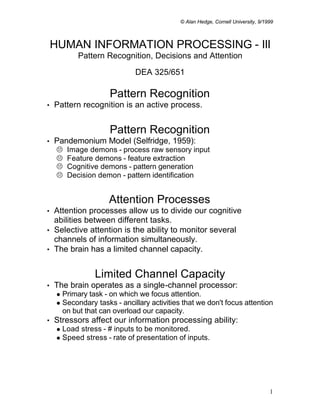Pattern
- 1. ÂĐ Alan Hedge, Cornell University, 9/1999 HUMAN INFORMATION PROCESSING - III Pattern Recognition, Decisions and Attention DEA 325/651 Pattern Recognition âĒ Pattern recognition is an active process. Pattern Recognition âĒ Pandemonium Model (Selfridge, 1959): K Image demons - process raw sensory input K Feature demons - feature extraction K Cognitive demons - pattern generation K Decision demon - pattern identification Attention Processes âĒ Attention processes allow us to divide our cognitive abilities between different tasks. âĒ Selective attention is the ability to monitor several channels of information simultaneously. âĒ The brain has a limited channel capacity. Limited Channel Capacity âĒ The brain operates as a single-channel processor: l Primary task - on which we focus attention. l Secondary tasks - ancillary activities that we don't focus attention on but that can overload our capacity. âĒ Stressors affect our information processing ability: l Load stress - # inputs to be monitored. l Speed stress - rate of presentation of inputs. 1
- 2. ÂĐ Alan Hedge, Cornell University, 9/1999 Signal-Detection Theory âĒ All decisions are based on probabilistic information. âĒ Ease of decision making depends upon the signal/noise ratio: l Signal - relevant input event l Noise - background nervous activity and/or irrelevant inputs âĒ For any event 4 outcomes are possible: hit, miss, false alarm, correct rejection. Signal-Detection Theory âĒ Possible response outcomes: l Hit - correct detection that signal is present. l Correct rejection - correct detection that the signal is absent. l Miss - failure to detect signal when this is present. l False alarm - incorrect detection of signal when this is absent. SDT - Response Criterion âĒ Response criterion - subjective criterion level that produces "signal present' response when exceeded. Represented by à (beta) = ratio of signal/noise. âĒ Response criterion affected by: l Signal probability - high probability, low criterion. l Costs/benefits - criterion increases as costs of a False Alarm increase (e.g. nuclear war). Criterion decreases as benefits of a Hit and costs of a Miss increase (e.g. cancer). SDT - Sensitivity âĒ Sensitivity is the keenness/resolution of the sensory system. In SDT it is called d' (d prime) and is the distance between the signal and noise peaks. The greater this distance the easier it is to correctly detect the signal. 2
- 3. ÂĐ Alan Hedge, Cornell University, 9/1999 Receiver-Operating Characteristics (ROCs) âĒ Binary decisions can be replaced by confidence ratings (minimum 4 points: certain signal; uncertain signal, uncertain noise, certain noise). âĒ Rating scale response can be used to compute a probability matrix and results plotted as an ROC curve. ROC curves âĒ Different ROC curves represent different degrees of observer bias at equivalent levels of signal detectability. âĒ The lower the ROC curve, the lower the detectability of the signal. 3



